

Vol. 40 (Issue 38) Year 2019. Page 4
SOROKIN, Andrey E. 1 & NOVIKOV, Sergey V. 2
Received: 19/06/2019 • Approved: 28/10/2019 • Published 04/11/2019
ABSTRACT: The current situation in the area of innovative development of the Russian economy is in bad condition and reveals pronounced tendencies for aggravation, especially in the areas of critical high production technologies. This creates strong social threats to national security. One of the main forming causes of the innovation crisis is the low management quality, including state regulation, which is done empirically. The existing regulatory framework is represented by unsystematic conglomerate of federal laws, decrees of the President of the Russian Federation and regulations of various levels. It does not contribute to the accelerated development of productive innovation activity. It seems necessary to synthesize a scientifically based mechanism for innovation implementation and legal regulations for its functioning. |
RESUMEN: La situación actual en el área del desarrollo innovador de la economía rusa está en malas condiciones y revela tendencias pronunciadas de agravamiento, especialmente en las áreas de tecnologías críticas de alta producción. Esto crea fuertes amenazas sociales para la seguridad nacional. Una de las principales causas de la crisis de innovación es la baja calidad de la gestión, incluida la regulación estatal, que se realiza empíricamente. El marco regulatorio existente está representado por un conglomerado no sistemático de leyes federales, decretos del Presidente de la Federación de Rusia y regulaciones de varios niveles. No contribuye al desarrollo acelerado de la actividad de innovación productiva. Parece necesario sintetizar un mecanismo con base científica para la implementación de la innovación y regulaciones legales para su funcionamiento. |
At present, the Russian economy is in a state of permanent systemic crisis, including the innovation crisis. This is caused by the critical state of national innovators as well as operators belonging to the field of security innovative activity (Alandarov and Tarkhanovsky, 2017).
Nonetheless, firstly, decisions on innovative projects are made insufficiently competently, secondly, this market has already forbidden accessing and rapidly expanding segments of critical innovations, and, thirdly, Russian innovators are mostly associated with the characters of the past innovation era (Kryukova et al., 2016).
Today at the world market, selling or buying any of the most remarkable technology for making "felt boots" is physically impossible for an infinitely long time. Unfortunately, there was a significant and unavoidable reverse technological separation of the Russian economy from the economies of the most developed countries of the world. The main part of technologies used in Russia consisted of acquired or copied technological products, but mostly – with fundamental simplifications (Alandarov and Tarkhanovsky, 2017). Furthermore, an increasing number of Russian innovators are beginning to suffer from a severe depletion of financial and economic potential, allowing for an exceptional focus on “short-term” and local innovation projects. It also contributes to increased competition even in areas considered to be unimportant due to Russia's joining the WTO, which was inevitable (Akhmetshin et al., 2017).
The described situation is fundamentally unacceptable in terms of the social development of Russian society, and in terms of ensuring its national security (Kryvonos et al., 2017).
The correction of the situation can and should take place in many ways, but an indispensable and important component of innovation recovery is a competent government policy, which materializes mainly in the government regulation of innovation operations.
The problems related to the state regulation of innovation activity began to be widely studied after the Second World War, when government intervention in the scientific and technical sphere increased. The American scientist K. Arrow made a significant contribution to the substantiation of the need for state support of innovation, he created the Arrow-Romer endogenous model of economic growth that shows steady economic development based on technological progress, which is a consequence of the result of training employees in the process of activity (Arrow, 1962). Among the Russian scientists involved in solving issues of innovation and state regulation of innovation, we can distinguish Dmitriev O.N. (Dmitriev and Novikov, 2017), and his work on the strategic problems and areas of development reorganization of the control systems of the high-tech complex of Russia, the formation of the program of anti-crisis management innovation in the high-tech enterprise of Russia in the industry Zolotov V.A. (2017), Ryasin V.I. (2017). He has highlighted in his works the ways of solving intersectoral socio-economic problems of the formation of the innovation economy of Russia (Ryasin, 2017)
The problems of formation of regional innovation systems and state regulation of their functioning received special attention of Ryzhakov E.D., in the work on innovative approaches to the development of the financial potential of a region (Ryzhakov, 2017), Savanovich S.V. engaged in assessing the state of innovation safety in the region based on the use of a system of criteria and indicators (Savanovich, 2017), Sapego Yu.M. highlighted in his work the formation of agro-industrial clusters as prospects for the innovative development of the region (Sapego, 2017), Safronova Yu.V., Yushin I.V. studied the role of innovative development of the region in ensuring food safety (Safronova and Yushin, 2017). Solonina S.V., Efanova D.I. evaluated the investment and innovation activity of the Krasnodar Krai (Solonina and Efanova, 2017; Takhumova et al., 2016).
Many scientists focused their research on the question of whether government stimulation of innovation in private companies brings results. The results of such studies are not unequivocal, much depends on the incentive method, the economic situation in these companies and the state of the economy as a whole (Mahmood and Rufin, 2005; Hall and Lerner, 2010; Carboni, 2017). Some scholars argue that government financial support for innovation is accepted positively by business, which encourages them to finance innovation more, including through their own funds (Lerner, 2000; Plaskova et al., 2017). Nonetheless, other scientists suggest that government funding for innovation, on the contrary, leads to the fact that commercial firms are beginning to save their money on innovation finance (Zhang and Wu, 2014; Mahmood and Rufin, 2005).
The given point of view of the influence of state financing on innovations is innately contrary. On the other hand, some researchers have long tried to reconcile these conflicting points of view in at least two different ways. Firstly, the various results of previous studies were explained by the influence of various factors on the object of study. For example, depending on the industry under research, institutional characteristics, parameters of the firms themselves (type of ownership, size, operating conditions), government incentives for innovation can have a different impact on companies' innovation activity (Lach, 2002; Mani, 2002; Huergo et al., 2016; Bezpalov, 2017). In addition, the degree of impact of various forms of government incentives for innovation can be different (Guan and Yam, 2015; Lee and Cin, 2010; Borrás and Edquist, 2013; Qiu and Tao, 1998; Lerner, 2000). Secondly, government stimulation of the innovation activity of private companies contributes to the growth of innovation activity to a certain level, after which the degree of influence and the positive effect of innovation start to decrease (Guan and Yam, 2015; Sakulyeva, 2018). In this study we will consider the influence of the state on innovation activity in Russia.
Theoretical and methodological basis of the study consists of the works of domestic economists in the field of innovative development of the economy, financial support for innovation, regulation of budgetary processes, as well as regulatory and methodological and legal documents regarding the selected research topic. As methods of this study, universal methods of cognition were used: analysis, synthesis, induction, deduction, empirical description, graphical analysis, historical method based on statistical data. Private methodical technics of economic and mathematical modeling and others have also been used (Dmitriev and Novikov, 2017; Dmitriev and Novikov, 2018; Novikov, 2018).
As information and regulatory base of the study were used the following: statistical materials, reporting data of the executive authorities; materials of monographs and publications of periodicals, Internet resources of leading research centers of Russia, the results of their own research, as well as: Decrees of the President of Russia, decrees of the Federal Government, other regulatory legal and methodological documents of the legislative and executive authorities of all levels of government of the Russian Federation, including some program documents.
For example, the Strategy for Scientific and Technological Development of the Russian Federation was the basis for the introduction of sectoral strategic planning documents in the field of scientific and technological development, made in the framework of goal-setting, state programs of the Russian Federation, state programs of constituent entities of the Russian Federation, as well as planning and program-targeted documents of state corporations, state-owned companies and joint stock companies with state participation.
Then, the priorities of the scientific and technological development of the Russian Federation are to be set in the strategy of scientific and technological development of the Russian Federation and should be the basis for the register of relevant technologies approved by the Government of the Russian Federation to be accepted when implementing the strategy of scientific and technological development of the Russian Federation.
As part of grounds for state support measures for innovation, we consider the state of the innovation sector of the Russian economy. To start, let's consider the volume of financing of innovation activities by the state for the years 2000-2017.
Figure 1
Dynamics of domestic expenditure on research and development (billion rubles.)
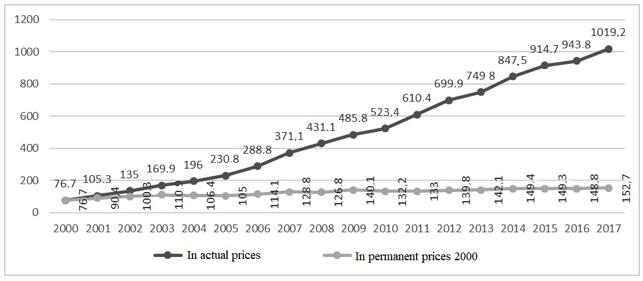
(Statistics of science and education ..., 2017)
The volume of domestic expenditures on research and development in Russia in 2017 amounted to 1019.2 billion rubles. (Figure 1), which is 2.6% (at constant prices) more than previous year. The growth of internal expenditures on research and development was shown both in current prices and in constant ones. In general, for the period 2000–2017 The dynamics of domestic expenditures on research and development, despite the uneven nature, look positive: their value has doubled in constant prices and increased in 13.3 times in current prices. Let us then compare the values of indicators of domestic expenditures on research and development in Russia with the dynamics of Russia's GDP.
Figure 2
Annual growth rates of domestic expenditures on research and
development and GDP (calculations are made in constant prices) (%))
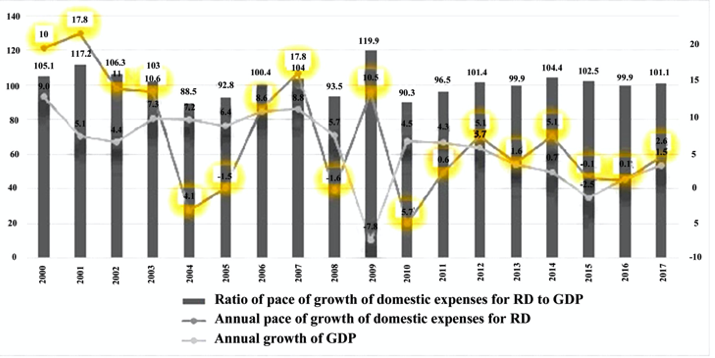
(Ratay, 2018)
The ratio of the growth of domestic spending on research and development to the growth of GDP for the period 2000-2017 is uneven, however, for the last 5 years shows steady growth, in other words, domestic expenditures on research and development are growing at a faster rate than Russia's GDP. In 2017, the ratio of the growth of domestic expenditure on RD to GDP was 101.1% (Figure 2). The highest value of this indicator was in 2009 – 119.9%, when in the conditions of the financial crisis, the volume of GDP decreased by 7.8% compared with the level of the previous year (in constant prices), while domestic expenditures on research and development increased by 10,5% due to an increase in research and development expenditures from the federal budget by 18.5%.
It should be said that in Russia the state plays an increasingly important role in the development of innovations (Figure 3).
Figure 3
Distribution of domestic expenses on research
and development by sources of funding (%)
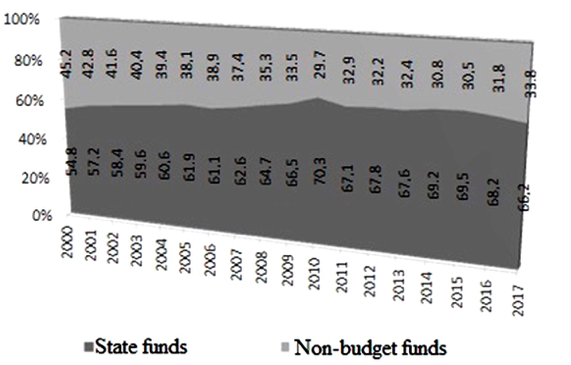
(Statistics of science and education..., 2017)
According to the data of 2017, two thirds (66.2%) of the internal expenditures on research and development accounted for state funds. For example, in 2000, the state financed 54.8% of all expenditures on research and development in Russia. Indicators of domestic expenditures for research and development in the context of the science sectors are also different (Figure 4).
Figure 4
Annual growth of domestic expenditures on research and development
in the sectors of science (Calculations are made in constant prices) (%)
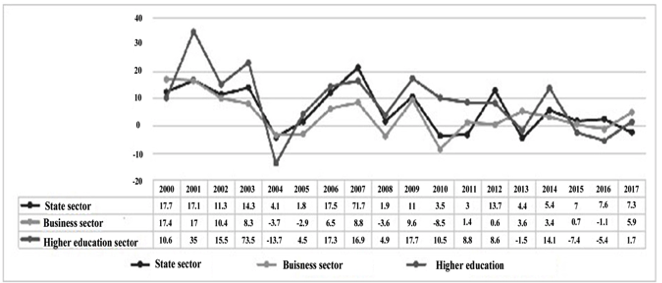
(Ratay, 2018)
As for the distribution of financial resources by sectors of science, there is unevenness in the dynamics of internal expenditures on research and development clearly manifested here. Intensively developing segment of internal science is the higher education sector: it is characterized by relatively high annual growth rates. The average annual growth in this sector for the period 2000–2017. (8.4%) was higher than in other sectors: public – 5.5%, business – 3.1%.
Figure 5
Structure of domestic expenditures on research
and development per sector of science (%)
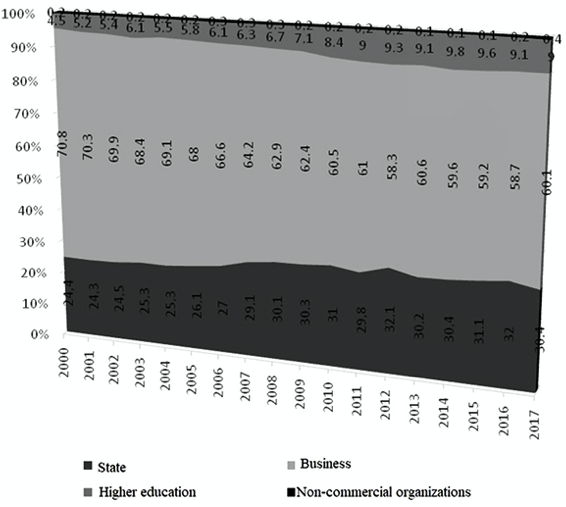
(Statistics of science and education..., 2017)
The value in absolute terms in 2017 compared with 2000 increased (in constant prices) for higher education sector by 3.9 times, in the public sector – by 2.5, in the business sector – by 1.7 times. At the same time, the size of higher education sector should be taken into account: its share in domestic expenditures on research and development, according to 2017, was 9% (Figure 5). The business sector provided 60.1%, determining the dynamics of the total volume of internal expenditures on research and development. The state sector accounted for less than a third of expenditures – 30.4% in 2017.
In general, for the period from 2000 to 2017 expenditures on research and development in sectors of science show decrease compared to domestic expenditures on research and development of state sector (from 24.4% to 30.4%) and the higher education sector (from 4.5 to 9%).The part of the business sector over the years has decreased from 70.8 to 60.1%.
Thus, financing innovations in Russia for the period from 2000 to 2017 can be characterized as follows:
1) We can observe an increase in research and development financing;
2) The growth rate of research and development financing is declining;
3) The role of the state in financing research and development is growing, and if we take into account the fact that the majority of Russian universities are funded by the state, the indicator of the state’s share in financing research and development will be even higher.
Despite the positive dynamics in development of the sphere of innovation in Russia, there are many constraining factors:
The solution of the above problems is only possible if the system approach to the formation of a project request in the field of science is changed – the transition from the state order system to the “public” order system.
This system should be grounded on the following principles:
1) Competition (when forming a public request, there should always be alternative solutions, while there should be competition at all levels – competition of performers, competition of main managers of budget funds among themselves, as well as concerning funds and development institutions for budget allocations);
2) Competent customer;
3) A balance between the public order system and research by initiative;
4) The allowance of reasonable risk in the implementation of scientific, technical and innovation activities;
5) Publicity of making of the public order.
Of course, the discussed transformations should be done with adaptation to the configuration of government bodies and, above all, the composition of the ministries. In this sense, the separation or merging of the regulation of scientific and educational spheres can significantly change the relevant regulatory system. It should be mentioned that the above considerations concern practically only domestic Russian innovation projects. In general, the following conceptual framework for the transformation of Russian innovation sphere in terms of its regulation on the part of government bodies is proposed:
1) An integrated organizational and economic innovation mechanism is being created (similar mechanisms can be seen, in particular, in organizational and economic methods, levers, tools for influencing managed objects) based on a comprehensive systems engineering design of internal and external innovation environments;
2) Testing of innovations is done in public administration of the economy and their refinement is based on the results of this testing;
3) Management innovations are introduced for general use.
The stated considerations provide a reason to form the following conclusions and recommendations:
1) In general, for the period from 2000 to 2017 in the structure of expenditures on research and development, the sectors of science show an increase in the total amount of domestic expenditures on research and development of specific part of the state sector (from 24.4% to 30.4%) and the higher education sector (from 4.5 to 9%).The part of business sector over the years has decreased from 70.8 to 60.1%;
2) The current situation in the area of innovative development of the Russian economy is in bad condition and reveals pronounced tendencies for aggravation, especially in the areas of critical high production technologies. This creates strong social threats to national security;
3) One of the main forming causes of the innovation crisis is the low management quality, including state regulation, which is done empirically;
4) The existing regulatory framework is represented by unsystematic conglomerate of federal laws, decrees of the President of the Russian Federation and regulations of various levels. It does not contribute to the accelerated development of productive innovation activity;
5) It seems necessary to synthesize a scientifically based mechanism for innovation implementation and legal regulations for its functioning.
Akhmetshin, E.M., Barmuta, K.A., Yakovenko, Z.M., Zadorozhnaya, L.I., Mironov, D.S., & Klochko, E.N. (2017). Advantages of cluster approach in managing the economy of the Russian Federation. International Journal of Applied Business and Economic Research, 15(23), 355-364.
Alandarov, R.A., & Tarkhanovsky, K.O. (2017). Comparative analysis of the methodology for organizing research funding on the example of the Russian Federation, Western Europe and Asia. Finances: Theory and Practice, 6(21), 166-178.
Arrow, K. (1962). Economic welfare and the allocation of resources for invention. In The Rate and Direction of Inventive Activity: Economic and Social Factors (pp. 609-626). Cambridge: National Bureau of Economic Research, Inc.
Bezpalov, V.V. (2017). Improving mechanisms to manage foreign trade activity of regional industrial complexes in the context of international limitations. European Research Studies Journal, 20(4), 319-333.
Borrás, S., & Edquist, C. (2013). The choice of innovation policy instruments. Technological Forecasting and Social Change, 80(8), 1513-1522.
Carboni, O.A. (2017). The effect of public support on investment and R&D: an empirical evaluation on European manufacturing firms. Technological Forecasting and Social Change, 117, 282-295.
Dmitriev, O.N., & Novikov, S.V. (2017). Conception of managing of fuzzy-institutional meso-level organizational separations in a context of product projects internationalization. European Research Studies Journal, 20(4), 277-289.
Dmitriev, O.N., & Novikov, S.V. (2018). Economic assessment of federal scientific programs. Russian Engineering Research, 38(4), 326-329.
Guan, J.C., & Yam, R.C. (2015). Effects of government financial incentives on firms' innovation performance in China: evidences from Beijing in the 1990s. Research Policy, 44(1), 273-282.
Hall, B.H., & Lerner, J. (2010). The Financing of R&D and Innovation, Handbook of the Economics of Innovation. Amsterdam: Elsevier.
Huergo, E., Trenado, M., & Ubierna, A. (2016). The impact of public support on firm propensity to engage in R&D: Spanish experience. Technological Forecasting and Social Change, 113, 206-219.
Kryukova, E., Vinichenko, M., Makushkin, S., Melnichuk, A., Bondaletov, V., & Potekhina, E. (2016). On sustainable economic development of the mono town of Baikalsk. International Journal of Economic Research, 13(6), 2409-2424.
Kryvonos, Y.G., Romanov, V.O., Galelyuka, I.B., Wójcik, W., Zyska, T., & Amirgaliyev, E. (2017). Independent devices and wireless sensor networks for agriculture and ecological monitoring. Recent Advances in Information Technology, 1,105-134.
Lach, S. (2002). Do R&D subsidies stimulate or displace private R&D? Evidence from Israel. Journal of Industrial Economics, 50(4), 369-390.
Lee, E.Y., & Cin, B.C. (2010). The effect of risk-sharing government subsidy on corporate R& D investment: empirical evidence from Korea. Technological Forecasting and Social Change, 77(6), 881-890.
Lerner, J. (2000). The government as venture capitalist: the long-run impact of the SBIR program. Science, 287, 977-979.
Mahmood, I.P., & Rufin, C. (2005). Government's dilemma: the role of government in imitation and innovation. Acad. Manag. Rev., 30 (2), 338-360.
Mani, S. (2002). Government, Innovation and Technology Policy: An International Comparative Analysis. Cheltenham: Edward Elgar Publishing.
Novikov, S.V. (2018). The features of innovative processes in the Russian Federation: analysis of current practices. Espacios, 39(39), 10.
Plaskova, N.S., Prodanova, N.A., Zatsarinnaya, Е.I., Korshunova, L.N., & Chumakova, N.V. (2017). Methodological support of organizations implementing innovative activities investment attractiveness estimation. Journal of Advanced Research in Law and Economics, 8(8), 2533-2539. DOI:10.14505/jarle.v8.8(30).25.
Qiu, L.D., & Tao, Z. (1998). Policy on international R&D cooperation: subsidy or tax? European Economic Review, 42(9), 1727-1750.
Ratay, T.V. (2018). Express information: internal costs of research and development in the Russian Federation: growth is planned. Higher School of Economics, Institute for Statistical Studies and Economics of Knowledge. Retrieved from: https://issek.hse.ru/data/2018/09/19/1153687012/NTI_N_102_19092018.pdf.
Ryasin, V.I. (2017). Ways of solving intersectoral socio-economic problems of the formation of the innovation economy of Russia. Scientific Thought, 1(23), 59-64.
Ryzhakov, E.D. (2017). Innovative approach to the development of the financial potential of the region. Innovative Development of the Economy, 2(38), 113-117.
Safronova, Yu.V., & Yushin, I.V. (2017). The role of innovative development of the region in ensuring food security. In Current Issues of Economics, Management and Finance in Modern Conditions, A Collection of Scientific Papers on the Results of the International Scientific-Practical Conference (pp. 62-64). Saint Petersburg: Nauka.
Sakulyeva, T. (2018). Megapolis public transport system. International Journal of Civil Engineering and Technology, 9(10), 647-658.
Sapego, Yu.M. (2017). Formation of agro-industrial clusters as a prospect of innovative development of the region. In The Russian Economy in the Face of New Challenges of the Modern Era Materials of the All-Russian Scientific-Practical Conference Dedicated to the 95th Anniversary of the Birth of M. A. Valiugin – the First Dean of the Economic Faculty of the National Research Mordovia State University Named after N.P. Ogarev (pp. 362-367). Saransk: National Research Mordovia State University named after N.P. Ogareva.
Savanovich, S.V. (2017). Assessment of the state of innovation security in the region based on the use of a system of criteria and indicators. In Current Economic Studies of Kaliningrad Universities Collection of Scientific Papers. Union of Compatriots of the Coastal Regions (pp. 53-59). Kazan: I. Kant Baltic Federal University, Institute of Economics and Management.
Solonina, S.V., & Efanova, D.I. (2017). Evaluation of investment and innovation activity of Krasnodar Region. Scientific Herald of the Southern Institute of Management, 4, 72-81.
Statistics of science and education (2017). Costs and sources of funding for research and development. Moscow: Federal Research Institute of Scientific and Technological Development. Retrieved from: http://csrs.ru/archive/stat_2017_finance/finance_2017.pdf
Takhumova, O.V., Lovyannikova, V.V., & Konovalova, I.A. (2016). Innovative mechanism for increasing the efficiency of regional agroindustrial sector. Actual Problems of Economics, 184(10), 228-234.
Zhang, X., & Wu, J. (2014). Research on effectiveness of the government R&D subsidies: evidence from large and medium enterprises in China. American Journal of Industrial and Business Management, 4(09), 503-513.
Zolotov, V.A. (2017). Managerial Problems and Tasks of the Formation of the Program of Anti-Crisis Management Innovation in the High-Tech Enterprise of Russian Industry. Moscow: KnoRus.
1. PhD in Economics. Associate Professor. Department of Ecology, Human Factors Systems and Life Protection. Moscow Aviation Institute (National Research University). Moscow. Russian Federation. E-mail: sorokin@mai.ru
2. PhD in Economics. Associate Professor. Department of Management and Marketing of High-Tech Industries. Moscow Aviation Institute (National Research University). Moscow. Russian Federation. E-mail: sv@mai.ru